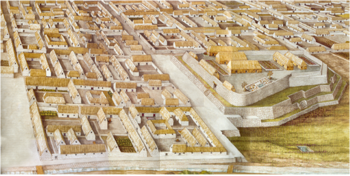Tualcacán
Tualcacán | |||||||
|---|---|---|---|---|---|---|---|
| 1335–1633 | |||||||
 Artist view of Tualcacán with the Moon Temple | |||||||
| Capital | Tualcacán | ||||||
| Common languages | Quepec | ||||||
| Religion | Tuachec religion | ||||||
| Government | Monarchy | ||||||
| History | |||||||
• Foundation | 1335 | ||||||
• Formation of the Tuachec Empire | 1400 | ||||||
• Destruction due to the Iberic conquest of Tualcacán | 1633 | ||||||
| Population | |||||||
• Estimate | 200,000 | ||||||
| |||||||
Tualcacán was a large Tuachec town in what is now the historic center of Santa Borbones. The exact date of the founding of the city is unclear, but the date 13 March 1335 was chosen in 1935 to celebrate the 600th anniversary of the city. The city was built next to what was then Lake Chacamaco in the Valley of Santa Borbones. The city was the capital of the expanding Tuachec Empire in the 14th century until it was captured by the Iberics in 1633. At its peak, it was the largest city in the pre-colonial Mesothalassa. Today, the ruins of Tualcacán are in the historic center of the Pecarian capital.
Etymology
Tualcacán can be interpreted as "The Sacred Place". The prefix "Tual" evoke something sacred in the Quepec language, referring to the city's importance as the seat of the empire. The suffix "cacán" can be associated with terms meaning "place" or "center," thus emphasizing the central nature of this city in the Tuachec Empire.
The City
The city of Tuacalcán was the capital of the vast Tuachec Empire and a shining example of pre-colonial Mesothalassa architecture and engineering. The city was designed in the shape of a jaguar, a sacred animal, symbolizing power and protection. Its central area, known as the Qillalajta (Temple of the Sun), was the spiritual heart, adorned with gold and dedicated to Inti, the sun god.
The city's streets were paved with stone, and its buildings were constructed with finely cut stone blocks that fit together without mortar, a hallmark of Tuachec stone masonry. Massive terraces surrounded the city, supporting agriculture and preventing erosion, while aqueducts brought water from the mountains to sustain the population. It was not only a religious and political hub but also a center of art, craft, and culture, reflecting the Tuachec's administrative power and reverence for the natural world.
Upon entering this magnificent city, we were struck by its awe-inspiring design. Towering walls of finely cut stone blocks fit so seamlessly that no mortar was needed, a technique reminiscent of the Tuachec's impeccable stone masonry. The city radiated order and sophistication, its streets bustling with people clothed in brilliantly woven garments, displaying their expertise in textile arts. At the edge of the plaza stood the Qillalajta Temple, a breathtaking structure dedicated to the Tuachec's moon deity named Quilla. Unlike other temples, its curved stone walls glistened under the sunlight, echoing the reverence the people held for the celestial forces. The temple's golden ornaments and intricate carvings depicted lunar cycles and the harmony between the sun and moon, central to their cosmology. This sacred place served as the spiritual heart of the city, where rituals and offerings were made to ensure the city's prosperity and the balance of the natural world.When we set foot on this unknown land, our eyes bore witness to an unparalleled marvel. It was the work of skilled architects, not the savages our men had been battling until then. The cobbled streets echoed with the murmur of the inhabitants, dressed in rich fabrics of vibrant colors, symbols of an unrivaled mastery of textile art.
Christiano Davegga in Chronicles of the New Wurld
The Fall
Tualcacán is conquered by Diego de Montega and his troops in 1633 after a lengthy siege. The majority of the population dies from hunger and diseases brought by the Iberians. When the city falls, it is extensively looted, and the surviving Tuachec people are enslaved. Having gained control, Montega then directed the systematic destruction and leveling of the city and began its rebuilding, despite opposition. The grand temples of the city are destroyed along with all statues of the Tuachec gods, considered heretical by the Iberians.
